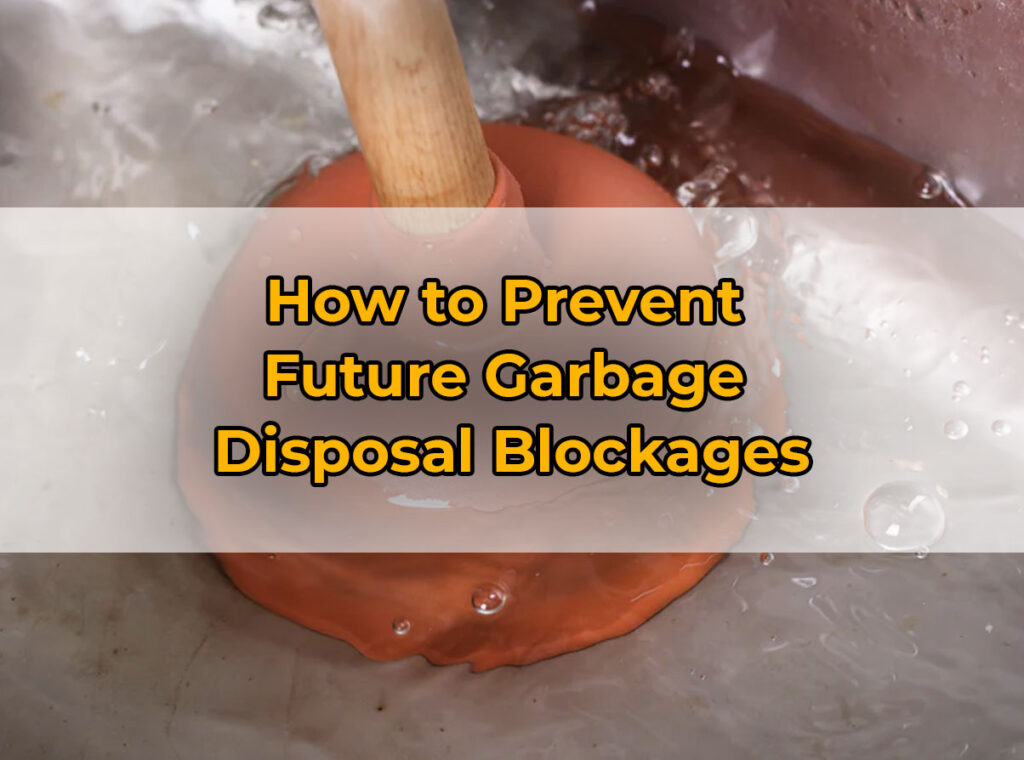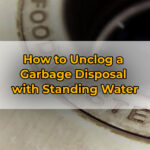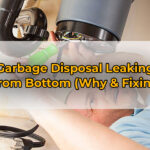Wondering on how to unclog a garbage disposal with standing water? If you have a garbage disposal, then you know how convenient it is to dispose of food waste. But what happens when it gets clogged?
Clogs can happen for various reasons, including putting the wrong kind of foods down the disposal or overusing it. One of the worst situations is when there’s standing water in your sink because of a clog.
Fortunately, there are some easy steps you can take to unclog your garbage disposal with standing water.
Common Causes of Garbage Disposal Blockages

Garbage Disposal Blockages: A Closer Look
It’s important to know why garbage disposals block. Here are some common causes:
1. Food particles
One of the most common causes of garbage disposal blockages is food particles. These small bits of leftover food can accumulate in the disposal, causing it to become jammed or slow-moving.
The types of food particles that cause the most problems are those that are fibrous or starchy in nature. Examples include celery, potato peels, rice and pasta. These foods can easily get tangled up in the blades of the garbage disposal and create a blockage that prevents water from flowing through properly.
2. Grease and fats
Grease and fats may seem harmless when we pour them down the drain, but they can wreak havoc on our garbage disposals. As these substances cool and solidify, they create a sticky layer inside the disposal that traps food particles and other debris. Over time, this buildup can lead to blockages that prevent the disposal from working properly.
To avoid this problem, it’s important to dispose of grease and fats properly. Instead of pouring them down the drain, collect them in a container and throw them in the trash once they’ve solidified.
3. Non-food items
Non-food items such as plastic, metal utensils, glass, and paper should never be put down a garbage disposal. These items can damage the blades or get caught in the pipes leading to the disposal causing blockages. Even small amounts of these materials can cause major problems.
4. Insufficient water flow
When using a garbage disposal, it is important to run plenty of water through it to help break down the food waste and flush it out of the system. Without enough water flow, the food particles can become trapped in the pipes, leading to clogs and even damage to the unit over time.
Insufficient water flow can occur for several reasons. One possibility is a low water pressure issue in your home’s plumbing system. Another potential cause could be improper installation or use of your garbage disposal.
5. Overloading the disposal
One of the most common causes of garbage disposal blockages is overloading the appliance with food waste. It’s important to remember that your disposal isn’t a trashcan, so avoid putting large amounts of food down it at once.
Another cause is putting hard or fibrous materials such as eggshells, corn husks, or potato peels into the disposal. These materials don’t break down easily and can cause serious damage to your unit’s blades and motor.
6. Lack of maintenance
One common cause of garbage disposal blockages is a lack of maintenance. Many homeowners forget about their garbage disposal and assume it will work well indefinitely without any intervention or care.
Unfortunately, this isn’t true. Food particles can accumulate inside the unit over time and create a blockage that prevents water from flowing through smoothly. The best way to avoid this problem is to clean your garbage disposal regularly by running cold water and grinding ice cubes or citrus peels inside it.
7. Damaged or worn-out parts
The blades inside the disposal can become dull or bent over time, reducing their effectiveness at shredding food waste. This can cause blockages and even damage to the motor. Additionally, the bearings and seals within the disposal may wear out, garbage disposal leaking from bottom or strange noises when in use.
Another source of damage comes from foreign objects accidentally dropped into the disposal. Hard items like bones or utensils can cause dents or chips on the blades, which will impact performance and eventually lead to complete failure.
How to Unclog a Garbage Disposal with Standing Water

To unclog a garbage disposal with standing water, follow this step-by-step guide. Begin by turning off the power and removing as much water as possible.
1. Turn Off the Power
To stay safe, cut off the power before unclogging your garbage disposal.
- Locate the circuit breaker and turn off the power.
- Or unplug the cord if there is one.
- Check with a multimeter or voltage tester to make sure there is no current.
- Now you can unclog your garbage disposal.
- Don’t forget to turn the power back on after you’re done.
Cutting off the power prevents electric shocks.
Don’t use harsh chemicals like drain cleaners or bleach for clogs with standing water. These could damage your unit or mix with other cleaners and cause harm. Check also: Garbage Disposal Wont Turn Off.
Go for eco-friendly options like baking soda and vinegar, or commercial enzyme-based cleaners. These will clear clogs and eliminate odors without harming your system.
No more pool parties in your garbage disposal. Drain the water and move on!
2. Remove as Much Water as Possible
For unclogging a garbage disposal with standing water, it is key to eliminate excess liquid. This can lead to an effective cleaning and restoring the appliance’s optimal functioning.
So, turn off the disposal and take protective measures. Wear gloves and goggles.
Next, use a clean sponge or small towels to mop out visible water in the sink bowl. Remove any debris with a spoon or tongs.
Manually shred clogged debris with a flashlight and pliers or tongs. But, be careful and don’t let anything enter the opening.
Research suggests that citrus fruits in the garbage disposals can make fewer problems due to its acidic agents.
So, plunge that drain and enjoy the standing water!
3. Use a Plunger on the Drain
Using a Suction Cup Plunger on the Garbage Disposal Outlet? No problem!
Turn off the power to your garbage disposal unit. Insert the plunger and press down until you feel the suction cup fit snugly around the opening.
Push down hard and lift up slowly. Do this for about 15-20 seconds. If needed, repeat until all blockages in your drainage system are removed.
Plunge aggressively and lift gradually. This will allow you to get rid of debris without damaging pipes and disposals.
Pro Tip: Pour hot water into the sink before inserting your plunger for extra effectiveness.
4. Attempt Using a DIY Solution
Tackle a clogged garbage disposal with ease! Utilize a DIY solution for an effective and affordable method. Unplug the power or switch off the circuit breaker. Then, pluck any debris or objects causing the clog with tongs or pliers.
Pour hot water down the drain. Add baking soda, followed by vinegar. Let the mixture sit for 15 minutes. Flush it out with hot water. Not all DIY solutions work for every clog. For tougher blockages or grease buildup, stronger methods may be required.
To avoid costly professional fees, don’t use harsh chemicals like drain cleaners. These can damage plumbing and harm the environment. Regularly clean and maintain your garbage disposal to prevent future clogs. Then, you’ll have no problem unclogging your garbage disposal on your own!
5. Clean the Garbage Disposal
Maintaining a clean and working garbage disposal is essential. This helps stop food waste from building up and causing clogs or bad odors. Here are six steps to clean yours:
- Turn off the power – Unplug it or switch off its circuit breaker.
- Clean with ice – Freeze vinegar and water in an ice cube tray. Put one cube down the disposal, and wait a few seconds between each one.
- Add baking soda and citrus – Pour in a half-cup of baking soda and slices of citrus fruit (lemons or oranges). Then run warm water until everything flushes down.
- Scrub with vinegar – Pour half a cup of white vinegar after the ice, and let it sit for 10-15 minutes before running cold water over it.
- Remove any leftovers – Use pliers or tongs to take out any solid items.
- Rinse thoroughly – Run water into the disposal for several minutes, removing any residue on its sides.
Remember to rinse out all cleaning materials, or they could cause blockages in pipes connected to the disposal. Check also: Garbage Disposal Humming but Not Working.
Leaving food waste can cause serious problems like clogged pipes or system failure, that can be costly. So, clean your disposal regularly to keep your kitchen in tip-top shape! Don’t forget to treat your garbage disposal like your best friend, or it may retaliate with clogs.
How to Prevent Future Garbage Disposal Blockages

To prevent future garbage disposal blockages after unclogging standing water, address the root cause of the issue.
1. Proper Usage of Garbage Disposal
Garbage disposals are a handy, yet often misused, appliance in many households. To stop future blockages, it is essential to learn how to use this device correctly.
Here’s a 6-step guide for proper usage:
- Dispose of small amounts of food waste at a time.
- Keep the cold tap running while the disposal is on.
- Cut large items into smaller parts before disposing.
- Don’t pour grease or oils down the drain.
- Stop non-food items like plastics and metal from entering the disposal unit.
- Clean and maintain the unit regularly.
Also, make sure no hard objects enter the disposal system as they can harm blades and cause clogs.
Additionally, grinding citrus peels or other natural cleaners through the system every now and then can help eliminate odors and buildup.
The Environmental Protection Agency (EPA) says that garbage disposals cause over 50% of sewer backups – which shows how important proper use and maintenance practices are.
Cleaning your garbage disposal regularly is like flossing your teeth – unpleasant, yet necessary to avoid a painful blockage.
2. Regular Cleaning and Maintenance
It is essential to keep your garbage disposal in good shape, so it continues working without any blockages or malfunctions. Maintaining the unit involves keeping it clean and well-maintained, thus preventing the buildup of grime, odors, and clogs. Here’s a 3-step guide to maintaining your garbage disposal:
- Clear the Drain: Run cold water for 15 seconds before and after using the disposal.
- Clean Regularly: Use a brush or food-safe cleanser to sanitize. Also grind up ice cubes and citrus peels to get rid of smells and keep blades sharp.
- Avoid Certain Items: Don’t put hard or fibrous items like bones or potato peels into the disposer, as they can clog drains.
In addition, use small amounts of food waste at a time, to reduce stress on the garbage disposal.
Be aware: overloading your garbage disposal can lead to damage over time. Too much food can jam the mechanism, forcing it to work harder than necessary. So, use your garbage disposal regularly, or it might come back to haunt you!
Conclusion
Summing Up: Clearing a Clogged Garbage Disposal.
Don’t panic! First, switch off the unit and stop the water flow. Then, take out any visible debris with pliers or tongs. Insert an Allen wrench into the bottom of the unit and turn it manually. Use vinegar to get rid of grease and baking soda to remove odors.
To keep your garbage disposal clean, put lemon slices or ice cubes down the drain. Avoid throwing fibrous or greasy food down the pipes. Severe cases need professional help.
Never pour cooking oils or fats down the garbage disposal. They harden when cooled. Always put them in trash bins, to avoid future clogs.
Is water supposed to sit in garbage disposal?
The answer to this question is no. Water should not be left sitting in a garbage disposal for an extended period of time. Garbage disposals work by grinding up food waste into small pieces that can easily be flushed down the drain with water. If water sits in the disposal for too long, it can cause food particles to become stuck and clog the drain.
Can I use Coke to unclog my sink?
Yes, the same carbonated beverage that we consume on hot summer days can also serve as an effective DIY solution for unclogging your sink.
The idea behind using Coke to unclog your sink is based on the fact that it contains phosphoric acid. This acid works as a powerful cleaning agent by breaking down any buildup or blockages in your pipes. Additionally, the carbonation in Coke helps create fizzing which can further aid in dislodging any stubborn debris.
To use Coke for unclogging your sink, start by pouring a 2-liter bottle of Coca-Cola into the affected drain. Let it sit for at least an hour before running hot water down the drain to flush out any remaining debris.
Is it OK to pour boiling water down a garbage disposal?
The answer is yes, it is generally safe to pour boiling water down a garbage disposal. In fact, doing so can help to dissolve grease and other build-up inside the unit. However, you should only do this if your pipes are in good condition and made of metal.
If you have plastic pipes or suspect that they may be damaged in any way, avoid pouring hot water down the drain as it can potentially melt or warp the pipes.
“There is no real ending. It’s just the place where you stop the story.”






